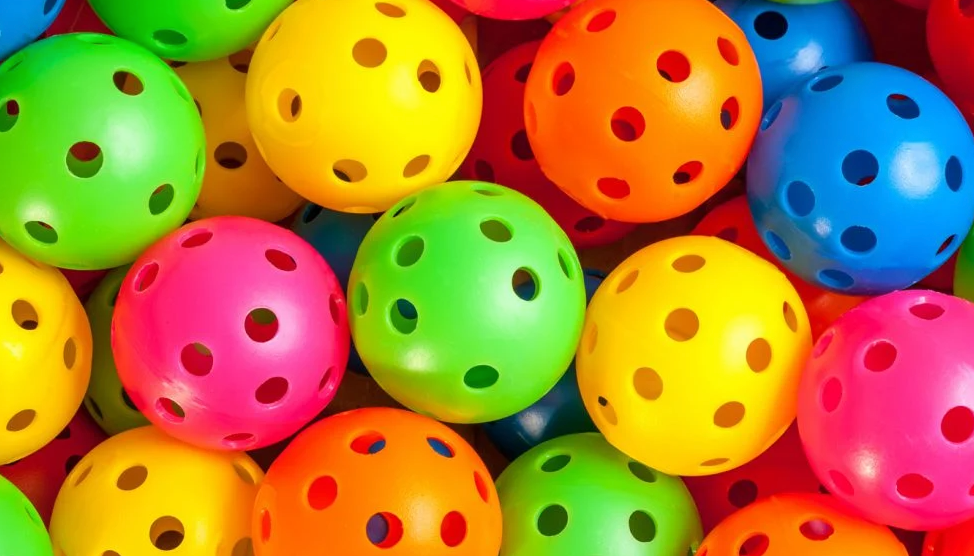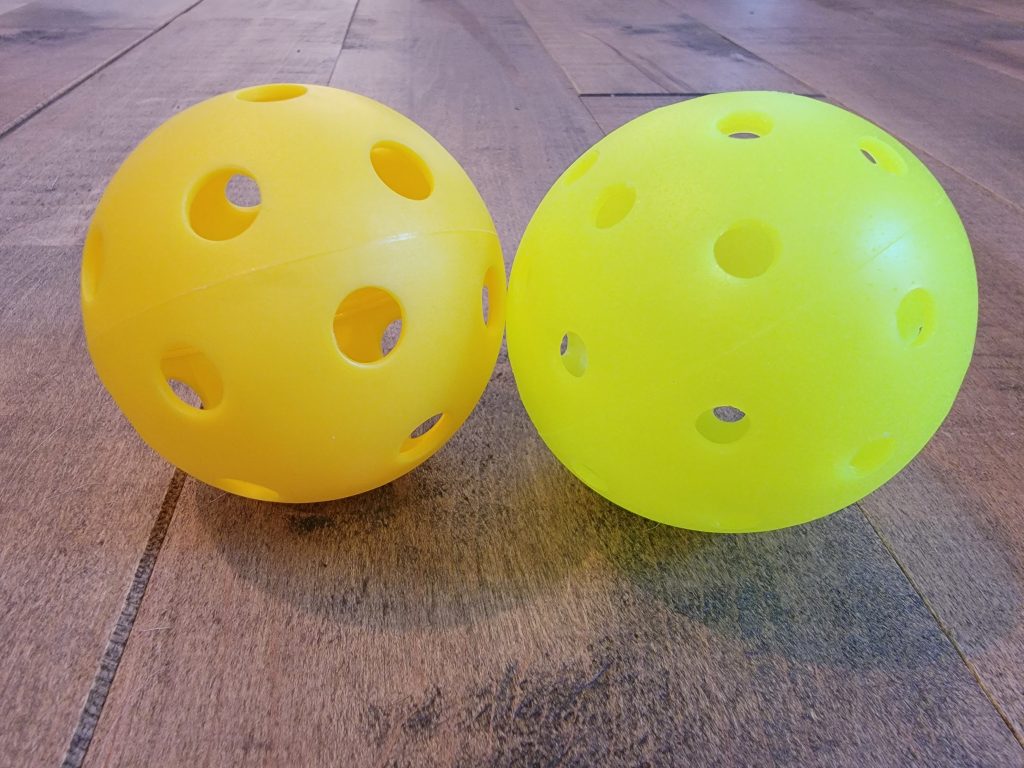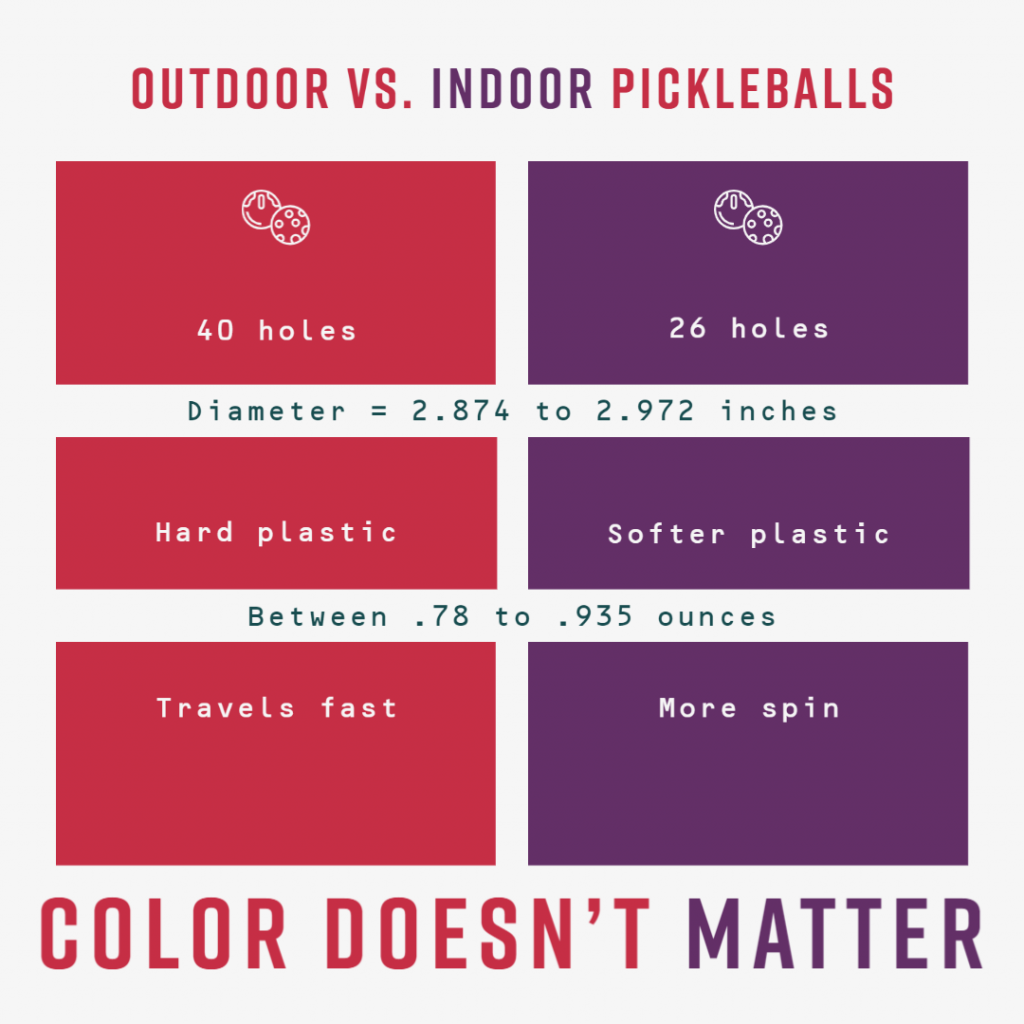Last Updated on November 20, 2025 by Drew Pierce
Pickleball balls. They serve us well, yet we give these small spheres very little thought or attention. In this post, we’ll explore everything there is to know about pickleball balls – from indoor vs. outdoor to colors to lifespan; how do you pick the best pickleball?
Since pickleball is a sport that requires minimal equipment to play, you’ll want to make sure you are mindful of the pickleball paddle you hit with and the ball that you put into play. While often an afterthought, I have found that the quality and health of the pickleball have a dramatic effect on the game, much more so than a baseball, soccer ball, and even tennis ball.

COLORS
What colors do pickleballs come in?
Most pickleballs are yellow, green, white, pink or blue. Some manufacturers offer additional color options, but yellow hues lead the pack.
There is no standardization among pickleball manufacturers regarding color, so a yellow pickleball from one manufacturer might be a different shade than a yellow pickleball from another manufacturer.
There is no performance difference between pickleballs of different colors. Some people prefer specific colors because they are easier to see, but it is ultimately a matter of personal preference.
Recently, I played with a ball that looked like a black and white cookie, split down the middle. Multicolor balls are not officially sanctioned; check the latest pickleball ball rules. And call me a traditionalist, but I’ll go with a classic neon yellow ball every time.

INDOORS vs. OUTDOORS
What is the difference between indoor and outdoor pickleballs?
The main difference between indoor and outdoor pickleballs is the material that they are made from. Indoor pickleballs are typically made from a softer plastic, while outdoor pickleballs are usually harder, potentially made from nylon or polyethylene.
Since indoor pickleballs are softer, they are generally easier to control, allowing for longer rallies and better control of the paddle. The larger holes also impact trajectory and speed, making return hits more predictable than a ball designed for outside play.
The type of plastic used affects the bounce and spin of the ball, so indoor pickleballs will typically have a lower bounce and less spin than outdoor pickleball.
The distinct characteristics of indoor and outdoor pickleballs significantly influence the gameplay, with indoor balls promoting longer rallies and outdoor balls resulting in a more fast-paced, aggressive game.

Indoor pickleballs are also usually brighter in color than outdoor pickleballs, making them easier to see indoors. There is also a difference in the number of holes each pickleball has. Indoor pickleballs have 26 holes, while outdoor pickleballs have 40 holes. The holes for an indoor pickleball ball are slightly larger. Outdoor pickleballs are less affected by the wind.

Indoor courts are made of various materials, and you might even find yourself playing on a gym floor. An indoor court’s smoothness, since it’s untouched by the elements, can be less damaging to your ball. The slightly heavier outdoor ball is made of thicker plastic and is designed to hold up against concrete or other outdoor court construction materials.
Personally, I enjoy playing with an outdoor ball at all times–and I have found the same to be true of many non-senior players.
The color of a pickleball is crucial for players to spot it quickly, especially in indoor environments. Darker colored balls, such as orange or yellow, are generally easier to see during play. Personally, I’m Team Yellow.
LIFESPAN
How long do pickleballs last?
The lifespan of a pickleball depends on a few factors, including the material it is made from, how often it is used, and whether it is stored properly. It also depends on the force with which the ball is hit. Please note, that if a pickleball becomes damaged during a point, a player can request that the point be played over.
At a minimum, consider swapping out your pickleball balls every few months to ensure they perform at their best. Playing with a “dead” or damaged ball can alter the speed and ultimately the fun of the game.
Many players will use a Sharpie to mark their pickleball balls. This can also help with ball longevity…at least when it comes to taking your balls home! 😉
Remember: The durability of outdoor pickleball balls may be impacted by extreme temperatures, causing them to crack more easily in cold weather or lose their integrity in hot conditions.
How Do I Know If a Pickleball Is Still Good?
Pro Tip: To ensure an outdoor pickleball maintains its optimal performance, it is essential to regularly check its roundness by spinning it and observing its movement.
What Is a Pickle Ball Made Of?
Pickleballs are crafted from materials like plastic, resin, or polymer. When it comes to indoor pickleballs, you’ll find that they are composed of a softer plastic compared to their outdoor counterparts.
USA PICKLEBALL SPECS
The USA Pickleball Association (USAPA) has a list of approved balls that meet their requirements for sanctioned tournament play, ensuring that players are using balls of suitable quality and design. As of this writing, there are 98 approved balls.
- 2.87”-2.97” in diameter
- Made of smooth material with no texture
- Solid color; any color is OK
- .78-.935 ounces in weight
- Bounce 30”-34” when tested based on their concrete plate testing standards
- 26-40 circular holes used to create flight characteristics
- Include an identification marking from the manufacturer
Who Makes the Best Pickle Balls?
There are numerous brands and models of indoor and outdoor pickleball balls available, such as the Onix Fuse indoor balls, Jugs indoor pickleball, Franklin X-40, and Dura Fast 40, all of which are designed for optimal performance in their respective playing environments.
| Product | Notes | Buy | |
|---|---|---|---|
 | Franklin Sports Outdoor Pickleballs - X-40 | USAPA approved; available in yellow, orange, pink | Click Here |
 | Onix Pure 2 Outdoor Pickleball Balls | USAPA approved; heavier weight | Click Here |
 | Gamma Photon Indoor or Outdoor Pickleballs | USAPA approved; high-visibility | Click Here |
 | Velocity Outdoor Pickleball Balls | USAPA approved; green, orange, yellow, pink | Click Here |
 | Selkirk SLK Competition Ball | | USAPA approved; crack resistant; lime green | Click Here |
 | PHYSIZZ Pickleball Balls | USAPA approved; comes with mesh bag | Click Here |

- 26 gram weight; 74mm diameter
- 40 precisely machine-drilled holes
- Package includes 12 ba

6 thoughts on “What Is the Difference Between Indoor and Outdoor Pickleball Balls?”